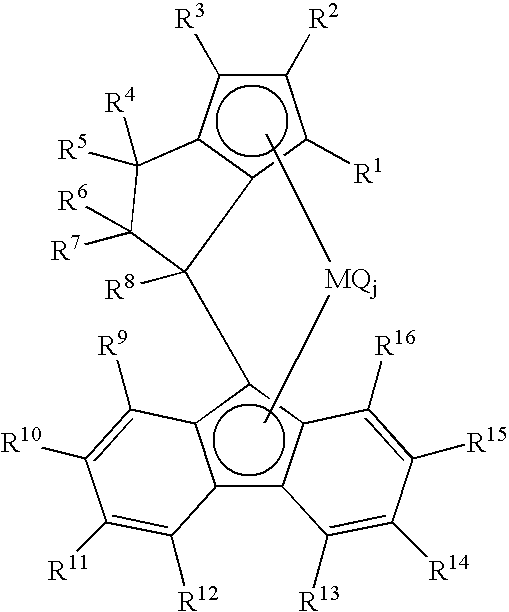Propylene Polymer, Composition Comprising the Polymer, and Molded Product Obtained Therefrom
- Summary
- Abstract
- Description
- Claims
- Application Information
AI Technical Summary
Benefits of technology
Problems solved by technology
Method used
Image
Examples
example 1a
(1) Production of Solid Catalyst Support
[0197] 300 g SiO2 (manufactured by Dokai Kagakusha) was introduced into a 1-L side-arm flask and then 800 ml toluene was added to form slurry. Then, the slurry was transferred to a 5-L four-neck flask, and 260 ml toluene was added. 2,830 ml solution of methyl aluminoxane (hereinafter abbreviated as MAO) in toluene (10 wt % solution manufactured by Albemarle Corporation) was introduced. The mixture was stirred at room temperature for 30 minutes. The mixture was heated over 1 hour to 110° C. and reacted for 4 hours. After the reaction was finished, the mixture was cooled to room temperature. After cooling, the supernatant toluene was removed and substituted with fresh toluene until the degree of substitution became 95%. (The term “degree of substitution” in the present invention refers to the degree of substitution of solvent; for example, when 9 L toluene is removed from 10 L toluene and 9 L heptane is added thereto to give 10 L, “the degree o...
example 2a
[0206] A polymer was obtained in the same manner as in Example 1a except that the polymerization method was changed as follows:
(1) Main Polymerization
[0207] 40 kg / hour propylene, 5 NL / hour hydrogen, 1.0 g / hour catalyst slurry produced in (3) in Example 1a as the solid catalyst component and 4.0 ml / hour triethyl aluminum were continuously supplied to a tubular polymerizer with an inner volume of 58 L and polymerized in the polymerizer filled up in the absence of a gaseous phase. The temperature of the tubular reactor was 30° C., and the pressure was 3.2 MPa / G.
[0208] The resulting slurry was sent to a vessel polymerizer with an inner volume of 1,000 L equipped with a stirrer and further polymerized. The polymerizer was fed with 45 kg / hour propylene and with hydrogen such that the concentration of hydrogen in the gaseous phase became 0.2 mol %. The polymerization was carried out at a polymerization temperature of 72° C. at a pressure of 3.1 MPa / G.
[0209] The resulting slurry was se...
example 3a
[0213] A polymer was obtained in the same manner as in Example 1a except that the polymerization method was changed as follows:
(1) Main Polymerization
[0214] 40 kg / hour propylene, 5 NL / hour hydrogen, 1.0 g / hour catalyst slurry produced in (3) in Example 1a as the solid catalyst component and 4.0 ml / hour triethyl aluminum were continuously supplied to a tubular polymerizer with an inner volume of 58 L and polymerized in the polymerizer filled up in the absence of a gaseous phase. The temperature of the tubular reactor was 30° C., and the pressure was 3.2 MPa / G.
[0215] The resulting slurry was sent to a vessel polymerizer with an inner volume of 1,000 L equipped with a stirrer and further polymerized. The polymerizer was fed with 45 kg / hour propylene and with hydrogen such that the concentration of hydrogen in the gaseous phase became 0.2 mol %. The polymerization was carried out at a polymerization temperature of 72° C. at a pressure of 3.1 MPa / G.
[0216] The resulting slurry was se...
PUM
| Property | Measurement | Unit |
|---|---|---|
| Temperature | aaaaa | aaaaa |
| Temperature | aaaaa | aaaaa |
| Temperature | aaaaa | aaaaa |
Abstract
Description
Claims
Application Information
 Login to View More
Login to View More - R&D
- Intellectual Property
- Life Sciences
- Materials
- Tech Scout
- Unparalleled Data Quality
- Higher Quality Content
- 60% Fewer Hallucinations
Browse by: Latest US Patents, China's latest patents, Technical Efficacy Thesaurus, Application Domain, Technology Topic, Popular Technical Reports.
© 2025 PatSnap. All rights reserved.Legal|Privacy policy|Modern Slavery Act Transparency Statement|Sitemap|About US| Contact US: help@patsnap.com



